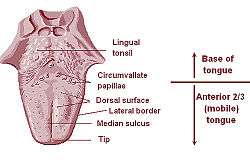Lingual tonsils
The lingual tonsils are two small mounds of lymphatic tissue located in the lamina propria of the root of the tongue.[1] The lymphatic tissue of the tonsils consists of the lymphatic nodules rich in cells of the immune system (immunocytes).[2] The immunocytes initiate the immune response when the tonsils get in contact with invading microorganisms (pathogenic bacteria, viruses or parasites).[2][3][4]
| Lingual tonsils | |
|---|---|
 Tongue | |
| Details | |
| System | Immune system (Lymphatic system) |
| Identifiers | |
| Latin | tonsilla lingualis |
| Anatomical terminology | |
Structure
Microanatomy
Lingual tonsils are covered externally by stratified squamous nonkeratinized epithelium that invaginates inward forming crypts. Beneath the epithelium is a layer of lymphoid nodules containing lymphocytes. Mucous glands located at the root of tongue are drained through several ducts into the crypt of lingual tonsils.[2][3] Secretions of these mucous glands keep the crypt clean and free of any debris.
Blood supply
Lingual tonsils are located on posterior aspect of tongue which is supplied through:[1]
- Lingual artery, branch of external carotid artery
- Tonsillar branch of facial artery
- Ascending and descending palatine arteries
- Ascending pharyngeal branch of external carotid artery
Nerve supply
Lingual tonsils are innervated by tonsillar nerves from the tonsilar plexus, formed by the glossopharyngeal and vagus nerves.[1]
Function

Like other lymphatic tissues, the function of lingual tonsils is to prevent infections. These tonsils contain B and T lymphocytes which get activated when harmful bacteria and viruses come in contact with tonsils. B lymphocytes kill pathogens by producing antibodies against them, while T lymphocytes directly kill them by engulfing them or indirectly by stimulating other cells of the immune system.[2][3][4]
Clinical significance
Cancer
Squamous cell carcinoma is a type of neoplasm that can affect lingual tonsils.[5]
Sleep apnea
Enlarged or hypertrophic lingual tonsils have the potential to cause or exacerbate sleep apnea.[6]
Additional images
- Lingual tonsil
- Lingual tonsil
- Lingual tonsils
This article incorporates text in the public domain from page 1138 of the 20th edition of Gray's Anatomy (1918)
External links
- Pictures at usc.edu(Registration required)
- Anatomy Atlases - Microscopic Anatomy, plate 09.163
- Histology image: 09802loa – Histology Learning System at Boston University
- MedEd at Loyola histo/HistoImages/hl6-27.jpg (labeled as 'lymphoid tissue')]
- Lingual Tonsil
References
- Moore, Keith L. (2013-02-13). Clinically oriented anatomy. Dalley, Arthur F., II,, Agur, A. M. R. (Seventh ed.). Philadelphia. ISBN 978-1451119459. OCLC 813301028.
- Mescher, Anthony L. Junqueira's basic histology : text and atlas. Junqueira, Luiz Carlos Uchôa, 1920- (Thirteenth ed.). New York. ISBN 9780071807203. OCLC 854567882.
- Ross, Michael H. (2011). Histology : a text and atlas : with correlated cell and molecular biology. Pawlina, Wojciech. (6th ed.). Philadelphia: Wolters Kluwer/Lippincott Williams & Wilkins Health. ISBN 9780781772006. OCLC 548651322.
- Abbas, Abul K. (2012). Cellular and molecular immunology. Lichtman, Andrew H., Pillai, Shiv. (7th ed.). Philadelphia: Elsevier/Saunders. ISBN 9781437715286. OCLC 698580696.
- Theodoraki, M-N.; Veit, J. A.; Hoffmann, T. K.; Greve, J. (2017-06-26). "Synchronous bilateral tonsil carcinoma: case presentation and review of the literature". Infectious Agents and Cancer. 12: 38. doi:10.1186/s13027-017-0146-5. ISSN 1750-9378. PMC 5485684. PMID 28670333.
- Badełek-izdebska, Małgorzata; Dębska, Małgorzata; Zawadzka-Głos, Lidia (2015-12-23). "Lingual Tonsil Hypertrophy as a Cause of Obstructive Sleep Apnea Syndrome – Case Report". New Medicine. 19 (4): 130–132. doi:10.5604/14270994.1191789. ISSN 1427-0994.